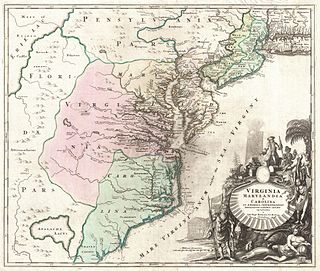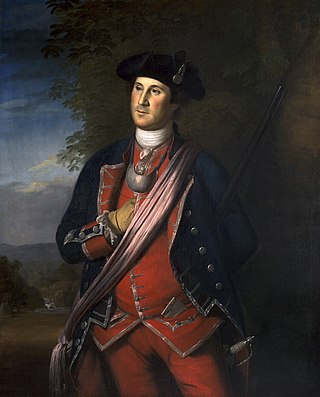
The Tuscarora are an Indigenous people of the Northeastern Woodlands in Canada and the United States. They are an Iroquoian Native American and First Nations people, based in New York and Ontario.

Gates County is a county located in the northeastern portion of the U.S. state of North Carolina, on the border with Virginia. As of the 2020 census, the population was 10,478, making it the fifth-least populous county in North Carolina. Its county seat is Gatesville. Gates County is included in the Virginia Beach-Chesapeake, VA-NC Combined Statistical Area. It is part of the Albemarle Sound area of the Inner Banks.

Murfreesboro is a town in Hertford County, North Carolina, United States. The population was 2,835 at the 2010 census. The town is home to Chowan University.

King Philip's War was an armed conflict in 1675–1676 between a group of indigenous peoples of the Northeastern Woodlands, the English New England Colonies and their indigenous allies. The war is named for Metacom, the Pokanoket chief and sachem of the Wampanoag who adopted the English name Philip because of the friendly relations between his father Massasoit and the Plymouth Colony. The war continued in the most northern reaches of New England until the signing of the Treaty of Casco Bay on April 12, 1678.

The Province of North Carolina, originally known as Albemarle Province, was a proprietary colony and later royal colony of Great Britain that existed in North America from 1712 to 1776.(p. 80) It was one of the five Southern colonies and one of the thirteen American colonies. The monarch of Great Britain was represented by the Governor of North Carolina, until the colonies declared independence on July 4, 1776.

The Province of Carolina was a province of the Kingdom of England (1663–1707) and later the Kingdom of Great Britain (1707–1712) that existed in North America and the Caribbean from 1663 until the Carolinas were partitioned into North and South on January 24, 1712.
John Jenkins was an English soldier and radical advocate for self-government. He served as governor of Albemarle four times: 1672–1675; 1676–1677; 1678–1679; 1680–1681, becoming the only person who has served as proprietary governor so many times.
A lord proprietor is a person granted a royal charter for the establishment and government of an English colony in the 17th century. The plural of the term is "lords proprietors" or "lords proprietary".

The colonial period of South Carolina saw the exploration and colonization of the region by European colonists during the early modern period, eventually resulting in the establishment of the Province of Carolina by English settlers in 1663, which was then divided to create the Province of South Carolina in 1710. European settlement in the region of modern-day South Carolina began on a large scale after 1651, when frontiersmen from the English colony of Virginia began to settle in the northern half of the region, while the southern half saw the immigration of plantation owners from Barbados, who established slave plantations which cultivated cash crops such as tobacco, cotton, rice and indigo.

The Meherrin people are an Indigenous people of the Northeastern Woodlands, who spoke an Iroquian language. They lived between the Piedmont and coastal plains at the border of Virginia and North Carolina.

The history of North Carolina from pre-colonial history to the present, covers the experiences of the people who have lived within the territory that now comprises the U.S. state of North Carolina.
The Esopus Wars were two conflicts between the Esopus tribe of Lenape Natives (Delaware) and New Netherlander colonists during the latter half of the 17th century in Ulster County, New York. The first battle was instigated by settlers; the second war was the continuation of a grudge on the part of the Esopus tribe.

The Occaneechi are Indigenous peoples of the Northeastern Woodlands whose historical territory was in the Piedmont region of present-day North Carolina and Virginia.

Albemarle County, North Carolina was a county located in the Province of North Carolina. It contained what is now the northeastern portion of the U.S. state of North Carolina.

The Chowanoc, also Chowanoke, were an Algonquian-speaking Native American tribe who historically lived near the Chowan River in North Carolina.

Colonial American military history is the military record of the Thirteen Colonies from their founding to the American Revolution in 1775.
Culpeper's Rebellion was a popular uprising in 1677 provoked by the enforcement of the Navigation Acts. It was led by settler John Culpeper against the ruling Lords Proprietor in Albemarle County, Carolina, near what is now Elizabeth City, North Carolina. The uprising met with only limited success, but Culpeper himself was acquitted of rebellion and became a hero, and the Lords Proprietor subsequently made efforts to strengthen the colony's government.
Thomas Eastchurch was governor of Albemarle County, North Carolina between 1675 and 1676. During his time in office, he imprisoned the former governor John Jenkins for various offenses. Jenkins was later released from prison with the aid of his supporters and reclaimed his position as governor in the spring of 1676. After Eastchurch explained the situation in London to the Lords Proprietors, they reappointed him as governor. In 1677, he left London to celebrate his honeymoon in Nevis Island. During his absence, his fellow proprietary Thomas Miller acted as governor. Miller's crimes created a revolt and Eastchurch, upon return to Albemarle, was unable to help the government recover. In addition, the Anti-Proprietors' leaders decided to send an army to the northern part of the Albemarle County to prevent the new governor from accessing Albemarle. Although Eastchurch sought aid to invade the county, he never got it. He did not return to the government of Albemarle until after the spring of 1676.











